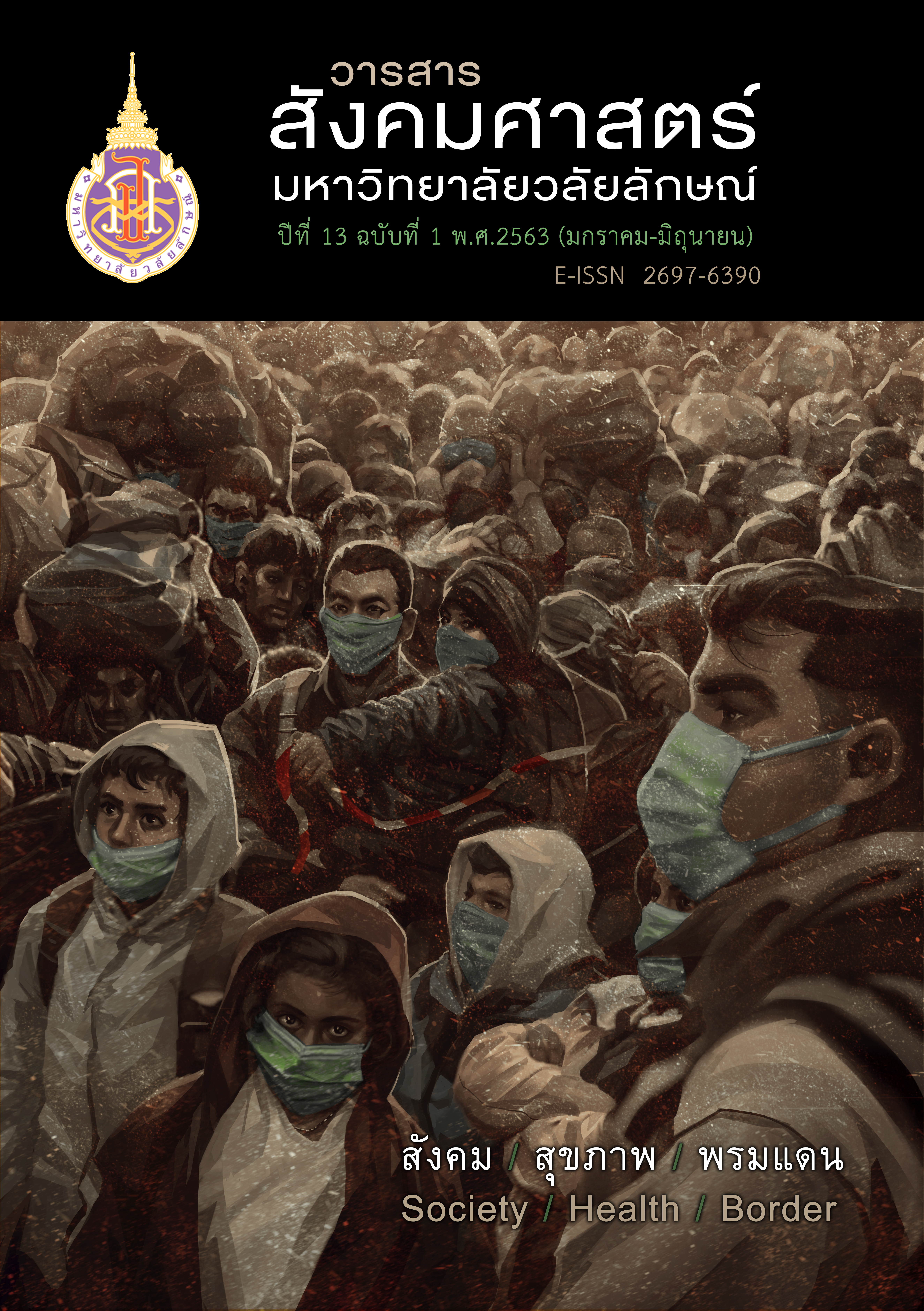Multiethnicity, Religions, and Trading Communities in Moreh Border Town, Manipur State
Main Article Content
Abstract
Moreh, a town in Manipur, shares a border with Myanmar and serves as India’s gateway to ASEAN. Its multicultural population, settled along the border transit routes, have been developing cross-border trade for half a century. This research focuses on these cross-border connections with data collected from fieldwork according to anthropological and sociological discipline principles to investigate the borderland situation since 2014. The findings reveal the community formations, religious practices, adaptations and a variety of expressions of identity, which make the heart of the borderland a multicultural society. The border markets have become a hub for a variety of products new to the locals, who have adapted their tastes to match the utility of new choices, and thereby revealing a fascinating dynamic to business. Groups involved in economic activities have developed trade practices that meet the demands of the period. Meanwhile, the Indian Government tries to accelerate progress by advancing borderland management.
Article Details
Copyright: CC BY-NC-ND 4.0
References
________. (2017). Hill District Councils in Manipur. Retrieved from http://mdoner.gov.in/node/753
________. (2017). Manipur. Retrieved from http://www.mdoner.gov.in/content/manipur-4
________. (2018). Indo-Myanmar border trade at Moreh-Namphalong and beyond. Journal of Global Economy, 14(2), 120-136.
Ahmed, S. (2012). Muslims at Indo-Myanmar border. Retrieved from http://twocircles.net/2012feb27/muslims_indomyanmar_border.html
ASEAN. (2012). First India-ASEAN Car Rally 2004. Retrieved from http://asean.org/?static_post=first-india-asean-car-rally-2004
Bhatia, R. (2016). India-Myanmar relations. New York, USA: Institute of Southeast Asian Studies.
Bhaumik, S. (2003). The returnees and the refugees: Migration from Burma. In Refugees and the State: Practices of Asyium and Care in India, 1947-2000 (pp. 182-210). New Delhi, India: Sage Publications India.
Brara, V. (2012). Expanding economic activity along the Sino-Indian border areas: A case study of Manipur and Arunachal Pradesh. IPCS Conference Report (p. 5). New Delhi, India: Institute of Peace and Conflict Studies.
Chandel District Unit, Manipur. (2019). District profile. Retrieved from https://chandel.nic.in/about-district
Chandran, D. S., & Singh, B. (2015). India, India, China and Sub-regional Connectivities in South Asia. New Delhi: SAGE Publications India.
Choudhry, R. (2015). Chinese ware wiping out Indian goods in Tamu. Retrieved from http://www.deccanherald.com/content/484351/ chinese-ware-wiping-indian-goods.html
Department of Tourism, Manipur. (2017). Manipur Tourism Policy 2017. Retrieved from http://manipur.gov.in/wp-content/uploads/2014/06/tourism-policy-full-final-new.pdf
Ediga, S. (2015). Manipur-The Jewel of India: North East India Part 3. Retrieved from https://factly.in/manipur-the-jewel-of-india-north-east-series-part3
E-Pao. (2012). Moreh under scanner for illegal migrants. Retrieved from http://e-pao.net/GP.asp?src=2..210912.sep12
Gangte, T. S. (2010). The Kukis of Manipur: A historical analysis. Delhi, India: Gian Ridhi Offset Printers.
Ganjanapan, A. (2012). Chintanākān thāng mānutsayawitthayā lǣo yō̜n mō̜ng sangkhom Thai. [The Anthropological imagination and looking back to Thai Society]. Chiang Mai, Thailand: Department of Sociology and Anthropology, Faculty of Social Sciences, Chiang Mai University.
Government of Manipur. (2018). At glance. Retrieved from http://manipur.gov.in/?page_id=3507
Hill Tribal Council Moreh. (2010). Hill Tribal Council Moreh, Silver Jubilee Celebration. Manipur, India: BCPW.
IANS. (2017). Hindu temples bombed near India-Myanmar International Border. Retrieved from http://www.hindustantimes.com/india-news/hindu-temples-bombed-near-india-myanmar-international-border/story-wq6JhYgZZOGCdkpTwThuZO.html
Imphal Free Press. (2018). Imphal-Moreh and Imphal-Tamenglong helicopter services lauched. Retrieved from https://www.ifp.co.in/page/items/53273/imphal-moreh-and-imphal-tamenglong-helicopter-services-launched
India, Census Population. (2015). Census 2011 data. Retrieved from http://www.census2011.co.in/census/district/378-chandel.html; http://www.census2011.co.in/census/state/manipur. html
India, Ministry of Development of North Eastern Region. (2011). Look East Policy and the North Eastern states. Retrieved from https://mdoner.gov.in/contentimages/files/Aspects_of_Look_East_Policy.pdf
India, Ministry of Home Affairs. (2019). Management of Indo-Myanmar Border. Retrieved from https://www.mha.gov.in/sites/default/ files/BMdiv_I_Annexure_I_30012020.pdf
Irene, S. (2010). The Muslims of Manipur. Delhi: Kalpaz Publications.
Kamwang, A. (2015). Nayōbāi Patibatkān Tawanʻō̜k Khō̜ng ʻIndīa Kap Thānglūang “Trai Phākhī” Chư̄amtō̜ ASEAN Læ Thai. [The “Act East Policy” of India and “Trilateral Highway” of ASEAN and Thailand Connectivity]. Journal of Social Sciences Naresuan University, 11(2), 137-166.
Ketthet, B. (2016). “Khonphan” Thư̄ak Himālai, Attalak, Withī, Watthanatham. [The Ethnic Groups in Himalayan Range and Their Identities Folkways]. Nakorn Patom, Thailand: Centre of Bharat Studies, Research Institute for Languages and Cultures of Asia, Mahidol University.
Konsam, M. (2013). Tales from Myanmar 2. Indo Myanmar Border Trade Bulletin (pp. 49-57). Manipur, India: Department of Economics, Manipur University.
Kymlicka, W. (1995). Mulicultural citizenship: A liberal theory of minority rights. Oxford: Oxford University Press.
Leepreecha, P. (2013). Phahu Watthanatham Niyom: Khwāmmāi Krabūanthat Læ Sathānaphāp. [Meaning, Paradigms, and the State of Multiculturalism Studies]. Journal of Social Sciences, 25(2), 2-27.
Manipur Online. (2018). Manipur profile. Retrieved from http://www.manipuronline.in/About/Profile/index.html
Nag, D. (2010). Local dynamics, universal context: Border trading through Moreh, Manipur. Retrieved from http://www.mcrg.ac.in/PP31.pdf
Rabibadhana, A. (2008). Watthanatham Khư̄ KhwāmmāI: Thritsadī Læ Withīkān Khō̜ng Clifford Geertz. [Culture is meaning: Theory and Methodology of Clifford Geertz]. Bangkok, Thailand: Princess Maha Chakri Sirindhorn Anthropology Cente.
Reimeingam, M. (2015). Moreh-Namphalong border trade. Bangalore, India: Institute for Social and Economic Change.
Roy, E. (2012). A border town called Moreh. Retrieved from http://archive.indianexpress.com/ news/a-border-town-called-moreh/980805/0
Santasombat, Y. (2008). ʻAmnāt Phư̄nthī Læ ʻAttalak Thāng Chāttiphan : Kānmư̄ang Watthanatham Khō̜ng Rat Chāt Nai Sangkhom Thai (I). [Power, Space and Ethnic Identities: Cultural Politics of Nation-State in Northern Thai Society (I)]. Bangkok, Thailand: Princess Maha Chakri Sirindhorn Anthropology Cente.
Santasombat, Y. (2012). Chon Chaidaen Kap Kankaokham Phromdaen. [Borderlanders and Border Crossing]. Chiang Mai, Thailand: Biodiversity and Indigenous Knowledge Studies Center for Research and Sustainable Development, Faculty of Social Sciences, Chiang Mai University, Thailand.
Singh, L. P. (2007). The people of Manipur. Retrieved from http://e-pao.net/epSubPageExtractor.asp?src=manipur.Ethnic_Races_Manipur.The_People_of_Manipur
Singh, T. B. (2007). India’s border trade with its neighbouring countries with special reference to Myanmar. Margin, 4(1), 359-382.
UCA News. (2002). Tamils, Kukis develop Catholic Unity in border town. Retrieved from http://www.ucanews.com/story-archive/?post_name=/2002/10/04/tamils-kukis-develop-catholic-unity-in-border-town&post_id=21403


